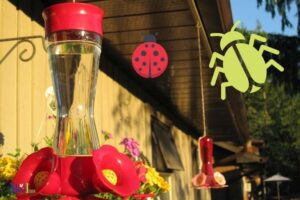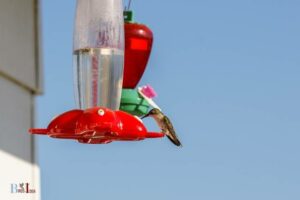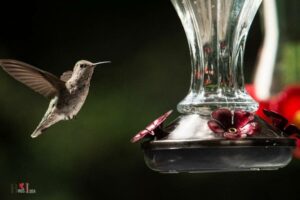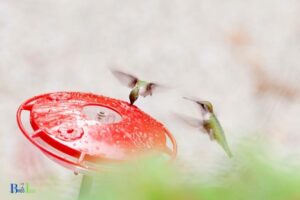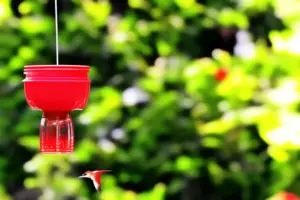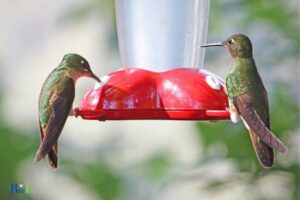How to Fill a Bottom Fill Hummingbird Feeder: Reattach!
To fill a bottom fill hummingbird feeder, you need to unscrew the base, fill the reservoir with nectar, reattach the base securely, and then hang it in a suitable location for the birds to access.
To fill a bottom fill hummingbird feeder, you need to unscrew the base, fill the reservoir with nectar, reattach the base securely, and then hang it in a suitable location for the birds to access.
Bottom fill hummingbird feeders are a popular choice for many birdwatchers due to their easy-to-use design and efficient filling process.
By following these simple steps, you can keep your hummingbird feeder clean and filled with fresh nectar, ensuring that the little birds continue to visit your garden.
Remember always to clean the feeder thoroughly before refilling to prevent the growth of potentially harmful mold or bacteria.
8 Steps: How to Fill a Bottom Fill Hummingbird Feeder
| Step | Action | Notes |
| 1 | Prepare the feeder | Clean the feeder thoroughly before filling to ensure it’s free of mold and debris |
| 2 | Mix the hummingbird nectar solution | Combine 4 parts water with 1 part white sugar; no need for red dye or artificial additives |
| 3 | Pour the nectar into the feeder | Use a funnel or a container with a spout to minimize spillage |
| 4 | Secure the bottom part of the feeder | Attach the base firmly to prevent leaks |
| 5 | Flip the feeder carefully | Quickly turn the feeder upside down to avoid nectar spillage |
| 6 | Check for leaks | Ensure there are no leaks and the base is securely attached |
| 7 | Hang the feeder in a suitable location | Choose a location near plants, in partial shade, and away from predators |
| 8 | Monitor the feeder and clean it regularly | Clean and refill the feeder every few days or when the nectar level is low to maintain hygiene |
Key Takeaway
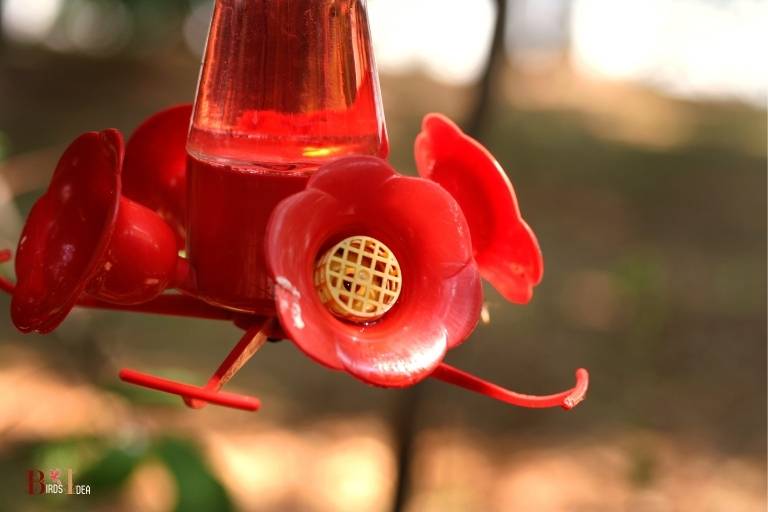
Four Facts About: Fill a Bottom Fill Hummingbird Feeder
Understanding Bottom Fill Hummingbird Feeders
Definition Of A Bottom Fill Hummingbird Feeder
If you’re new to bird feeding, you may be wondering what a bottom fill hummingbird feeder is. In simple terms, it is a feeder designed to make filling and cleaning your feeder an easy and convenient process.
With a bottom fill hummingbird feeder, you can fill the feeder without having to remove it from its hanger or pole.
Overview Of The Benefits Of Using A Bottom Fill Feeder
Now that you know what a bottom fill hummingbird feeder is, you may be wondering why you should consider using one.
Here are some of the key benefits of using a bottom fill feeder:
- Convenience: Filling a bird feeder can be messy and time-consuming, but with a bottom fill feeder, you can easily add nectar without having to take it down from its hanging location.
- Reduced spills: The bottom fill feature of this feeder type also helps to prevent spillage and mess that often occurs with top-fill models.
- Easy clean-up: Cleaning up the feeder can be a hassle. But with a bottom fill option, it’s much easier to clean the feeder since you can access the feeder much more quickly and with ease.
Explanation Of How A Bottom Fill Feeder Works
A bottom fill feeder has a basin where the nectar is poured in from the bottom instead of the top like traditional feeders.
When filling up your bottom-fill hummingbird feeder, make sure to follow these simple steps:
- Remove the bottom cap from the feeder.
- Fill the container with the nectar, while using particular measurement instructions to prevent the overflow of liquid.
- Replace the bottom cap.
- Hang the feeder in its designated spot and wait for the hummingbirds to come and enjoy!
Note that you should always refer to your feeder’s instructions on how much nectar to fill it with, how and when to clean it, and when to replace it, as these details may differ depending on the model.
Choosing a bottom fill hummingbird feeder for your backyard is a great way to provide food for the hummingbirds that visit while making maintenance more manageable for you.
By following the instructions that come with your feeder, you’ll be able to keep it clean and filled with nectar to ensure that the hummingbirds in your area keep visiting you for a sweet treat!
Steps To Fill A Bottom Fill Hummingbird Feeder
Filling a hummingbird feeder can be a fun and rewarding experience for bird lovers. When it comes to bottom fill hummingbird feeders, there are a few steps you need to follow to make sure your feeder is filled effectively.
- First, you should remove your hummingbird feeder from its hanging spot. Carefully unscrew the bottom of the feeder and remove it.
- Take the top of the feeder off and set it aside. Be sure to remember which end goes where, so you don’t put it together backward.
- Use a funnel to pour the nectar syrup into the feeder’s bottom compartment. Make sure not to overfill the feeder and leave a bit of empty space for the syrup to mix with the air and prevent leaks.
- Put the feeder’s bottom back and screw it tight. Now you can turn the feeder over so that the syrup will flow into the top compartment.
- Finally, place the top of the feeder back on and hang it up again for the hummingbirds to enjoy.
Discussion Of Tools Needed To Fill A Bottom Fill Feeder
One of the great things about a bottom-fill feeder is that it requires fewer tools than other types of feeders.
To fill your bottom fill hummingbird feeder, you’ll only need a few simple items:
- Hummingbird nectar syrup: This can be store-bought or homemade and is the essential food for filling your feeder.
- A funnel: This tool makes filling your feeder a breeze and helps prevent spills.
- A clean cloth or paper towel: To wipe away any syrup spills or drips on your feeder or counter.
Tips For Avoiding Common Mistakes When Filling A Bottom Fill Feeder
Here are some common mistakes to avoid when filling a bottom fill hummingbird feeder:
- Be sure not to overfill your feeder as that can cause leaks.
- Avoid putting too much syrup in your feeder if you live in hot climates. In warm weather, the syrup can ferment and become harmful to hummingbirds. As a general rule
- It’s essential to keep your feeder clean to prevent mold or bacteria growth. Before refilling, wash your feeder with soap and warm water and rinse it well.
- Change the nectar syrup every two to three days to prevent spoilage and bacteria growth, especially in hot weather.
By following these simple steps and tips, you can keep your bottom fill hummingbird feeder clean, filled, and ready to attract beautiful hummingbirds all season long.
Maintaining A Bottom Fill Hummingbird Feeder
Overview Of The Importance Of Maintaining A Bottom Fill Feeder
Hummingbirds are one of the most fascinating creatures to watch. In order to catch them in action, it’s important to keep your hummingbird feeder clean so that it remains hygienic and inviting to these tiny birds.
A bottom fill feeder is an excellent option for those who want to keep their hummingbird feeders free from contaminants and easily refillable.
Here’s why maintaining a bottom fill feeder is crucial.
- A clean feeder will attract more hummingbirds, which means that you’ll get to see more of these beautiful birds.
- Dirty feeders can spoil the sugar water, causing mold and bacteria to grow and making the food unappealing or even dangerous to hummingbirds.
- Regular cleaning of the feeder ensures the longevity of your feeder, so you can continue to enjoy it for years.
Explanation Of How Often To Clean A Bottom Fill Feeder
While a bottom fill feeder is designed to make cleaning and maintenance more straightforward, it still requires regular cleaning.
Here are some guidelines to follow:
- Clean your feeder once a week at a minimum, especially in hot weather.
- If the sugar water has begun to ferment, change it immediately.
- If you notice any mold or black spots in the feeder, wash it thoroughly even if it’s only been a few days since the last cleaning.
Step-By-Step Instructions For Cleaning And Maintaining A Bottom Fill Feeder
Maintaining a bottom fill feeder is relatively easy and should become a regular part of your feeder routine.
Follow these simple cleaning steps:
- Empty any remaining nectar from the feeder and disassemble it, making sure to remove the bottom cap.
- Rinse the feeder with soap and warm water. If the feeder is particularly dirty, add a few drops of white vinegar to the soapy water.
- Disinfect the feeder by soaking it in a solution of 1-part white vinegar to 4 parts water for at least 10 minutes.
- Use a special hummingbird feeder brush to clean any hard-to-reach areas, such as the feeder’s feeding ports and small crevices.
- Rinse the feeder thoroughly with clean water and let it dry completely before assembly and filling.
By following these simple steps, you can keep your bottom fill feeder clean and ensure that it provides a healthy habitat for hungry hummingbirds.
FAQ Of How To Fill A Bottom Fill Hummingbird Feeder
How Do I Fill A Bottom Fill Hummingbird Feeder?
How Often Should I Refill My Bottom Fill Hummingbird Feeder?
How Do I Clean My Bottom Fill Hummingbird Feeder?
What Type Of Nectar Should I Use For My Hummingbird Feeder?
Conclusion
To sum up, filling and maintaining a bottom fill hummingbird feeder is an easy task that requires a few simple steps. The most important thing to keep in mind is to clean the feeder regularly, especially during hot and humid weather conditions.
Remember to always use fresh nectar and avoid adding food coloring, artificial sweeteners, or honey which can be harmful to hummingbirds.
Using a bottom fill feeder can also help reduce spills and waste, making it a more efficient and eco-friendly solution.
By following these guidelines, you can create a safe and welcoming feeding station for hummingbirds in your backyard. Happy bird watching!

